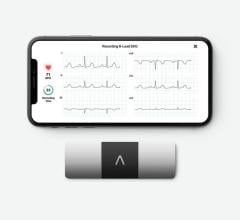
March 6, 2009 – VectraCor Inc. submitted its 510(k) application to the FDA in December for a new technology to derive 22-lead ECG function from only five electrodes
VectraCor said its VectraplexECG will allow the calculation of a 12, 16, 19, or 22 lead ECG (n-lead ECG) from the measurement of three standard ECG leads that are acquired from just five electrodes. The company said it is the first to that can detect in real time an acute myocardial infarction with the same five electrodes.
According to the American Heart Association (AHA), in 2005 about 80.7 million Americans had one or more forms of cardiovascular disease (CVD), and this number is expected to rise as the population continues to age adding increased cost pressure to a healthcare system already financially challenged. The cost of cardiovascular diseases and stroke in 2008 is estimated by the American Heart Association at $448.5 billion which is almost a quarter of the annual $2 trillion estimated healthcare dollar. VectraCor said its patented technology will have a significant impact on lowering diagnostic costs while improving cardiac diagnosis and patient care in the CVD sector.
The standard of care for any patient entering any acute care setting, such as an emergency department, with a potential cardiac condition includes connecting the patient to a cardiac rhythm monitor. The purpose of the cardiac monitoring device is to measure the heart rate and identify the presence or absence of an arrhythmia. In connecting the cardiac monitor to the patient, three to five electrodes are placed on the patient’s torso. In addition, every patient with a potential cardiac disorder will receive a standard 12-lead resting electrocardiogram (ECG), which is measured with the placement of 10 additional electrodes using a different portable stand-alone machine that requires a technician, nurse, or physician for acquisition.
The VectraplexECG can eliminate the additional leads and separate monitoring device. Additionally, VectraCor said its technology will incorporate the world’s first patented “electrical cardiac marker” (VectraplexAMI) that in real-time will detect whether a patient is developing an acute myocardial infarction (AMI). The VectraplexAMI will be displayed on the cardiac monitor as a number in real-time, in the same manner as the heart rate. If the patient begins to develop an AMI, the electrical marker index displayed on the cardiac monitor will change, setting up an internal and audible alarm that will result in the automatic printout of the derived n-lead ECG for interpretation by the physician. This immediate feedback will enhance the efficiency of diagnosis. For the Holter ,onitor, this will be the first time a product will alarm to notify the patient that they may be having an AMI, and when the patient arrives at the hospital or doctor’s office, the staff can print up to a 22 lead ECG.
The company said its technology embedded in any existing or new ECG or cardiac monitor will deliver a derived 12-22 lead ECG from a three lead (four to five electrode) configuration (the standard ECG consists of 12 leads acquired from 10 body surface electrodes) on demand, reducing the need for a technician managed mobile ECG system and eliminating excess electrode placement. The company said fewer electrodes also would translate into reducing the ECG acquisition error due to the variability of electrode placement.
VectraCor said its technology uses advanced mathematical models to derive ECGs with 98-99 percent accuracy. In development for more than 25 years, the company has examined in excess of 700 ECGs in proving the reliability of the system and the validity of the information produced.
For more information: www.vectracor.com


 November 21, 2023
November 21, 2023 








